Popular categories
Looking for a yarn?

100% Cotton
from 2.05 $ /50g
Order DROPS Safran from Wool Warehouse Direct Ltd

|
DROPS Safran uni colour 100% Cotton |
2.05 $ /50g |
Order |
Clicking the ORDER button will redirect you to Wool Warehouse Direct Ltd website
The yarn cost is calculated from the pattern’s smallest size and the yarn’s cheapest product type. Looking for an even better price? You might find it on the DROPS Deals!
Shy Violet Cardigan
Crochet DROPS jacket with fan pattern, worked top down in ”Safran”. Size S-XXXL.
DROPS design: Pattern no e-230
Yarn group A
----------------------------------------------------------
Size: S/M – L/XL – XXL - XXXL
Finished measurements:
Bust: 84-106-128-148 cm / 33"-41¾"-50½"-58"
Full length: 48-52-56-58 cm / 19"-20½"-22"-22¾"
Materials:
DROPS SAFRAN from Garnstudio
250-350-350-400 g color no 53, light purple
DROPS CROCHET HOOK size 3.5 mm/E/4 – or size needed to get 2 repetitions of A.4 = approx. width 10.5 cm / 4¼".
DROPS MOTHER-OF-PEARL BUTTON: Round (purple), NO 619: 5-5-6-6 pieces
-------------------------------------------------------
Alternative Yarn – See how to change yarns here
Yarn Groups A to F – Use the same pattern and change the yarn here
Yarn usage using an alternative yarn – Use our yarn converter here
-------------------------------------------------------

100% Cotton
from 2.05 $ /50g
Order DROPS Safran from Wool Warehouse Direct Ltd

|
DROPS Safran uni colour 100% Cotton 2.05 $ /50g Order |
Clicking the ORDER button will redirect you to Wool Warehouse Direct Ltd website
The yarn cost is calculated from the pattern’s smallest size and the yarn’s cheapest product type. Looking for an even better price? You might find it on the DROPS Deals!
- English (US/in)
- Česky
- Dansk
- Deutsch
- Eesti keel
- English (UK/cm)
- Español
- Français
- Íslenska
- Italiano
- Magyar
- Nederlands
- Norsk
- Polski
- Português
- Suomi
- Svenska
- English (UK/cm), Bulgaria
- English (UK/cm), Croatia
- English (UK/cm), Greece
- English (UK/cm), Latvia
- English (UK/cm), Lithuania
- English (UK/cm), Romania
- English (UK/cm), Slovenia
- Česky, Slovakia
Pattern instructions
See diagrams A.1 to A.9. The diagrams show all rows in pattern seen from RS.
BUTTONHOLES:
Measure from neck edge at the front and sew buttons on left band:
SIZE S/M: 1, 9, 17, 25 and 33 cm /
3/8", 3½", 6¾", 9¾", 13".
SIZE L: 1, 10, 19, 28 and 37 cm /
3/8", 4", 7½", 11", 14½"
SIZE XL/XXL: 1, 8, 16, 24, 32 and 40 cm /
3/8", 3⅛", 6¼", 9½", 12½", 15¾".
SIZE XXXL: 1, 9, 17, 25, 33 and 41 cm /
3/8", 3½", 6¾", 9¾", 13", 16⅛"
----------------------------------------------------------
JACKET:
The piece is worked top down.
RIGHT FRONT PIECE:
Work 69-92-114-137 ch (includes 3 ch to turn with) on hook size 3.5 mm/E/4 with Safran.
ROW 1 (= WS): Work 1 dc in 4th ch from hook (= 2 dc), 1 dc in each of the next 5-3-5-3 ch, * skip ch 1, work 1 dc in each of the next 4 ch *, repeat from *-* the entire row = 55-73-91-109 dc. NOW MEASURE PIECE FROM HERE!
Now work according to diagram, i.e. work as follows:
ROW 1-6: (1st row = RS): Work A.2, A.3, A.4 2-3-4-5 times in total, A.5, A.6. REMEMBER THE CROCHET GAUGE!
ROW 7 (= RS): Work last row in A.2-A.5 as before but finish with A.8 over A.6.
Continue until A.8 has been worked 1 time vertically, in A.2-A.5 repeat rows in A.x. Do not cut the yarn.
Take a new strand and work 1 sl st in 3rd ch at beg of last row and 22 ch for neck. Cut the yarn and continue with first strand.
Work over all sts, beg from RS as follows: A.2, A.3, A.4 4-5-6-7 times in total, A.5, finish with A.7 (= band). Continue like this. When piece measures approx. 24-26-28-30 cm / 9½"-10¼"-11"-11¾" – adjust after 7th row, sleeves are done.
Then work as follows, beg from WS: Work A.7 (= band), A.5, A.4 3-4-5-6 times in total, A.3, finish with A.2 (do not work the last 3 ch-spaces). Continue like this until piece measures approx. 48-52-56-58 cm / 19"-20½"-22"-22¾", adjust after 5th row in diagram. Fasten off.
LEFT FRONT PIECE:
Work as right front piece to and with 6th row.
ROW 7 (= RS): Work last row in A.3-A.6 as before but start with A.9 over A.2.
Continue until A.9 has been worked 1 time vertically, in A.3-A.6 repeat rows in A.x. Work 22 ch at the end of row for neck.
Now work over all sts, beg from RS as follows: A.1 (= band), A.3, A.4 4-5-6-7 times in total, A.5, finish with A.6. Continue like this. When piece measures approx. 24-26-28-30 cm / 9½"-10¼"-11"-11¾" – adjust after right front piece, sleeves are done. Cut the yarn.
Then work as follows, beg from WS: Skip 3 ch-space, beg by working in next sc as follows: A.6, A.5, A.4 3-4-5-6 times in total, A.3, finish with A.1 (= band). Continue like this until piece measures approx. 48-52-56-58 cm / 19"-20½"-22"-22¾", adjust after right front piece. Fasten off.
BACK PIECE:
Work left shoulder in ch-row from cast on edge (work in same ch as dc's, i.e. in the 55-73-91-109 dc) from left front piece as follows:
ROW 1-6: (1st row = RS): Work A.2, A.3, A.4 2-3-4-5 times in total, A.5, A.6. Cut the yarn.
Work right shoulder as left shoulder but in right front piece - NOTE! Instead of cutting the yarn work 71 ch for neck at the end of row, fasten with 1 sl st in first ch at beg of last row on left shoulder. Cut the yarn.
Now work over all sts, beg from RS as follows: NOTE: (Work first row as first row in diagram A1-A.6, then A.x) Work A.2, A.3, A.4 9-10-11-12 times in total, A.5, finish with A.6. Continue like this. When piece measures approx. 24-26-28-30 cm / 9½"-10¼"-11"-11¾" – adjust after front piece, sleeves are done. Cut the yarn.
Then work as follows, beg from WS: Skip 3 ch-space, beg by working in next sc as follows: A.6, A.5, A.4 7-8-9-10 times in total, A.3, finish with A.2 (do not work the last 3 ch-spaces). Continue like this until piece measures approx. 48-52-56-58 cm / 19"-20½"-22"-22¾", adjust after front piece. Fasten off.
ASSEMBLY:
Sew side and underarm seams in one. Sew buttons on to the left band - see explanation above. Button through a hole in right front piece.
EDGES:
Work an edge along the neck, beg from band on right front piece as follows: Work * 1 sc, 5 ch *, repeat from *-* along the neck with approx. 2 cm / ¾" between every sc until band on left front piece. Turn piece with 5 ch and work as follows: 1 sc in first ch-space, * ch 5, 1 sc in next ch-space*, repeat from *-* the entire row and finish with 5 ch and 1 sc in first ch from previous row. Fasten off.
Work an edge at the bottom along front and back piece the same way, beg from band on left front piece. Work an edge around the sleeve the same way, beg from mid under sleeve.
This pattern has been corrected. Click here to see the correction/s.
New chart A.9 (was missing 1 dc around st and 1 sc in st).
New chart A.9 in DROPS 162-14
LEFT FRONT PIECE:... ROW 7 (= RS): Work last row in A.3-A.6 as before but start with A.9 over A.2...
Diagram
All measurements in charts are in cm.

|
= 1 ch |

|
= 1 sc around st |

|
= 1 sc in st |

|
= 1 dc in st |

|
= 1 dc around st |

|
= row is explained in pattern (1 ch counts as 1 dc when it applies to shoulders, but ch-row applies to neck) |

|
= beg on diagram here |

|
= shows beg/end of A.x |

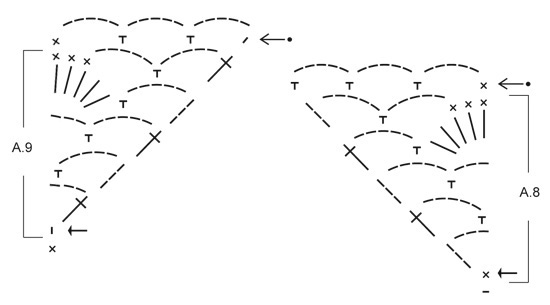
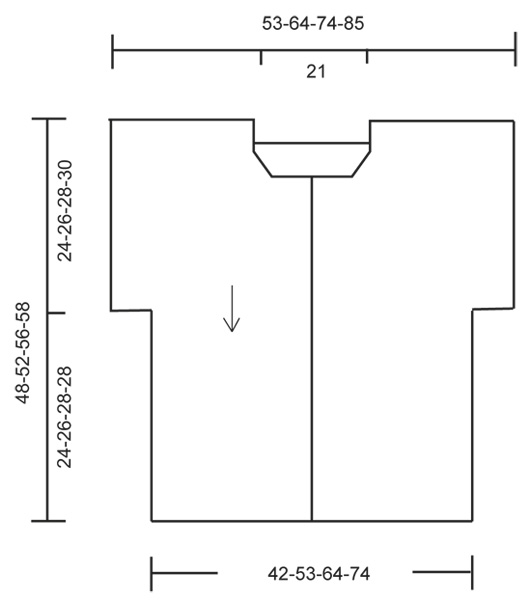
What can you do with our patterns? You can share DROPS patterns online, using the pattern original picture, materials, name and number. But you are NOT ALLOWED to reproduce the complete pattern digitally in any way. Yarn stores are welcome to use the DROPS pattern database to promote the sale of our assortment. You can print out our patterns, make as many copies as you’d like. The only thing we ask is that you don't make any changes / additions to the original printed document. And that the patterns according to the DROPS philosophy are given out to the consumers for free. Editorials that wish to publish our patterns in printed books or magazines can contact us for more information. The sale of garments based on DROPS patterns is permitted as long as they are sold as single items or per order. Further commercial use of the patterns is not permitted. It has to be clearly stated that the garment is made based on a design from DROPS DESIGN. The use of clothing labels of which DROPS DESIGN forms part is conditioned by the inclusion of the following text: “A DROPS DESIGN made by …..”. The use of DROPS photos for marketing purposes/sales is only permitted in connection with the use/sale of DROPS products. The photos may not be cut or edited and the logo should be clearly visible.
We reserve the right to withdraw the permission for use of our patterns at any time, notwithstanding the reason.
Each of our patterns has specific tutorial videos to help you.
These step-by-step tutorials might also help you:
Why is the knitting/crochet tension so important?
Knitting tension is what determines the final measurements of your work, and is usually measured per 10 x 10 cm. It is provided like so: number of stitches in width x number of rows in height - eg: 19 stitches x 26 rows = 10 x 10 cm.
The knitting tension is very individual; some people knit/crochet loosely while others work tightly. You adjust the knitting tension with the needle size, which is why the suggested needle size only serve as a guide! You need to adjust this (up or down) to ensure that YOUR knitting tension matches the knitting tension provided in the pattern. If you work with a different knitting tension than provided you will have a different yarn consumption, and your work will have different measurements than what the pattern suggests.
The knitting tension also determines which yarns can replace each other. As long as you achieve the same knitting tension you can replace one yarn with another.
See DROPS lesson: How to measure your tension/gauge
See DROPS video: How to make a gauge tension swatch
How do I know how many balls of yarn I need?
The required amount of yarn is provided in grams, eg: 450 g. To calculate how many balls you’ll need you first need to know how many grams are in 1 ball (25g, 50g or 100g). This information is available if you click on the individual yarn quality on our pages. Divide the amount required with the amount of each ball. For example, if each ball is 50g (the most common amount), the calculation will be as follows: 450 / 50 = 9 balls.
Can I use a different yarn than what the pattern suggests?
The important thing when changing from one yarn to another is that the knitting/crochet tension remains the same. This is so that the measurements of the finished piece will be the same as on the sketch provided. It is easier to achieve the same knitting tension using yarns from the same yarn group. It is also possible to work with multiple strands of a thinner yarn to achieve the knitting tension of a thicker one. Please try our yarn converter. We recommend you to always work a test swatch.
Please NOTE: when changing yarn the garment might have a different look and feel to the garment in the photo, due to individual properties and qualities of each yarn.
See DROPS lesson: Can I use a different yarn than the one mentioned in the pattern?
What are the yarn groups?
All our yarns are categorised into yarn groups (from A to F) according to thickness and knitting tension – group A contains the thinnest yarns and group F the thickest. This makes it easier for you to find alternative yarns to our patterns, should you wish to switch yarn. All yarns within the same group have a similar knitting tension and can easily replace each other. However, different yarn qualities have different structures and properties which will give the finished work a unique look and feel.
How do I use the yarn converter?
At the top of all our patterns you’ll find a link to our yarn converter, which is a helpful tool should you wish to use a different yarn than suggested. By filling in the yarn quality you wish to replace, the amount (in your size) and number of strands, the converter will present good alternative yarns with the same knitting tension. Additionally it will tell you how much you’ll require in the new qualities and whether you’ll need to work with multiple strands. Most skeins are 50g (some are 25g or 100g).
If the pattern is worked with multiple colours, every colour will have to be converted separately. Similarly, if the pattern is worked with several strands of different yarns (for example 1 strand Alpaca and 1 strand Kid-Silk) you will have to find alternatives for each, individually.
Why do you show discontinued yarns in the patterns?
Since different yarns have different qualities and textures we have chosen to keep the original yarn in our patterns. However, you can easily find options among our available qualities by using our yarn converter, or simply pick a yarn from the same yarn group.
It is possible that some retailers still have discontinued yarns in stock, or that someone has a few skeins at home that they would like to find patterns for.
The yarn converter will provide both alternative yarn as well as required amount in the new quality.
What size should I knit?
If you think it's hard to decide what size to make, it can be a good idea to measure a garment you own already and like the size of. Then you can pick the size by comparing those measures with the ones available in the pattern's size chart.
You'll find the size chart at the bottom of the pattern.
See DROPS lesson: How to read size chart
Why do I get the wrong knitting tension with the suggested needle size?
The needle size provided in the pattern serves only as a guide, the important thing is to follow the knitting tension. And since knitting tension is very individual, you will have to adjust the needle size to ensure that YOUR tension is the same as in the pattern – maybe you’ll have to adjust 1, or even 2 needle sizes, up or down to achieve the correct tension. For this, we recommend that you work test swatches.
Should you work with a different knitting tension than the one provided, the measurements of the finished garment might deviate from the measurement sketch.
See DROPS lesson: How to measure your tension/gauge
See DROPS video: How to make a gauge tension swatch
Why is the pattern worked top-down?
Working a garment top-down provides more flexibility and room for personal adjustment. For example it is easier to try the garment on while working, as well as making adjustments to length of yoke and shoulder caps.
The instructions are carefully explaining every step, in the correct order. Diagrams are adjusted to the knitting direction and are worked as usual.
How do I work according to a knitting diagram?
The diagram depicts all rows/rounds, and every stitch seen from the right side. It is read from bottom to top, from right to left. 1 square = 1 stitch.
When working back and forth, every other row is worked from the right side and every other row is worked from the wrong side. When working from the wrong side, the diagram will have to be worked reversed: from left to right, knit stitches are purled, purl stitches are knit etc.
When working in the round every round is worked from the right side and the diagram are worked from right to left on all rounds.
See DROPS lesson: How to read knitting diagrams
How do I work according to a crochet diagram?
The diagram depicts all rows/rounds, and every stitch seen from the right side. It is worked from bottom to top, from right to left.
When working back and forth every other row is worked from the right side: from right to left and every other row is worked from the wrong side: from left to right.
When working in the round, every row in the diagram are worked from the right side, from right to left.
When working a circular diagram you start in the middle and work your way outwards, counter clockwise, row by row.
The rows usually start with a given number of chain stitches (equivalent to the height of the following stitch), this will either be depicted in the diagram or explained in the pattern.
See DROPS lesson: How to read crochet diagrams
How do I work several diagrams simultaneously on the same row/round?
Instructions for working several diagrams after each other on the same row/round, will often be written like so: “work A.1, A.2, A.3 a total of 0-0-2-3-4 times". This means you work A.1 once, then A.2 is worked once, and A.3 is repeated (in width) the number of times provided for your size – in this case like so: S = 0 times, M = 0 times, L=2 times, XL= 3 times and XXL = 4 times.
The diagrams are worked as usual: begin with the first row in A.1, then work the first row in A.2 etc.
See DROPS lesson: How to read knitting diagrams
See DROPS lesson: How to read crochet diagrams
Why are the sleeves shorter in larger sizes?
The total width of the garment (from wrist-to-wrist) will be larger in the larger sizes, despite the actual sleeves being shorter. The larger sizes have longer sleeve caps and wider shoulders, so there will be a good fit in all sizes.
Where on the garment is the length measured?
The measurement sketch/schematic drawing provides information regarding the full length of the garment. If it’s a jumper or a jacket the length is measured from the highest point on the shoulder (usually closest to the neckline), and straight down to the bottom of the garment. It is NOT measured from the tip of shoulder. Similarly, the length of yoke is measured from the highest point on the shoulder and down to where yoke is split into body and sleeves.
See DROPS lesson: How to read a schematic drawing
What is a repeat?
Diagrams are often repeated on the round or in height. 1 repeat is the diagram the way it appears in the pattern. If it says to work 5 repeats of A.1 in the round, then you work A.1 a total of 5 times after/next to each other in the round. If it says to work 2 repeats of A.1 vertically/in height you work the entire diagram once, then begin again at the start and work the entire diagram one more time.
Why does the piece start with more chain stitches than it’s worked with?
Chain stitches are slightly narrower than other stitches and to avoid working the cast-on edge too tight, we simply chain more stitches to begin with. The stitch count will be adjusted on the following row to fit the pattern and measurement sketch.
Why increase before the rib edge when the piece is worked top-down?
The rib edge is more elastic and will contract slightly compared to, for example, stocking stitch. By increasing before the rib edge, you avoid a visible difference in width between the rib edge and the rest of the body.
Why increase in the cast-off edge?
It’s very easy to cast off too tightly, and by making yarn overs while casting off (and simultaneously casting these off) you avoid a too tight cast off edge.
See DROPS video: How to bind off with yarn overs (yo)
How do I increase/decrease on every 3rd and 4th row/round alternately?
To achieve an even increase (or decrease) you can increase on, for example: every 3rd and 4th row alternately, like so: work 2 rows and increase on the 3rd row, work 3 rows and increase on the 4th. Repeat this until the increase is complete.
See DROPS lesson: Increase or decrease 1 st on every 3rd and 4th row alternately
How can I work a jacket in the round instead of back and forth?
Should you prefer to work in the round instead of back and forth, you may of course adjust the pattern. You’ll need to add steeks mid-front (usually 5 stitches), and follow the instructions. When you would normally turn and work from the wrong side, simply work across the steek and continue in the round. At the end you’ll cut the piece open, pick up stitches to work bands, and cover the cut edges.
See DROPS video: How to knit steeks and cut open
Can I work a jumper back and forth instead of in the round?
Should you prefer to work back and forth instead of in the round, you may of course adjust the pattern so you work the pieces separately and then assemble them at the end. Divide the stitches for the body in 2, add 1 edge stitch in each side (for sewing) and work the front and back pieces separately.
See DROPS lesson: Can I adapt a pattern for circular needles into straight needles?
Why is the pattern slightly different than what I see in the photo?
Pattern repeats can vary slightly in the different sizes, in order to get the correct proportions. If you’re not working the exact same size as the garment in the photo, yours might deviate slightly. This has been carefully developed and adjusted so that the complete impression of the garment is the same in all sizes.
Make sure to follow instructions and diagrams for your size!
How do I make a women’s size garment into a men’s size one?
If you have found a pattern you like which is available in women’s size it’s not very difficult to convert it to men’s size. The biggest difference will be the length of sleeves and body. Start working on the women size that you think would fit across the chest. The additional length will be worked right before you cast off for the armhole/sleeve cap. If the pattern is worked top-down you can add the length right after the armhole or before the first decrease on sleeve.
Regarding additional yarn amount, this will depend on how much length you add, but it is better with a skein too many than too few.
How do I prevent a hairy garment from shedding?
All yarns will have excess fibres (from production) that might come off as lint or shedding. Brushed yarns (ie hairier yarns) have more of these loose, excess fibres, causing more shedding.
Shedding also depends on what is worn under or over the garment, and whether this pulls at the yarn fibres. It’s therefore not possible to guarantee that there will be no shedding
Below are some tips on how to get the best result when working with hairier yarns:
1. When the garment is finished (before you wash it) shake it vigorously so the looser hairs come off. NOTE: do NOT use a lint roller, brush or any method that pulls at the yarn.
2. Place the garment in a plastic bag and put it in your freezer - the temperature will cause the fibres to become less attached to each other, and excess fibres will come off easier.
3. Leave in the freezer for a few hours before taking it out and shaking it again.
4. Wash the garment according to the instructions on the yarn label.
Why does my garment pill?
Pilling is a natural process that happens to even the most exclusive of fibers. It's a natural sign of wear and tear that is hard to avoid, and that is most visible in high friction areas of your garment like a sweater's arms and cuffs.
You can make your garment look as new by removing the pilling, using a fabric comb or a pill/lint remover.
In the meantime, you can read the questions and answers that others have left to this pattern or join the DROPS Workshop on Facebook to get help from fellow knitters/crocheters!
You might also like...
Shy Violet Cardigan |
|||||||||||||||||||||||||
 |
 |
||||||||||||||||||||||||
Crochet DROPS jacket with fan pattern, worked top down in ”Safran”. Size S-XXXL.
DROPS 162-14 |
|||||||||||||||||||||||||
|
PATTERN: See diagrams A.1 to A.9. The diagrams show all rows in pattern seen from RS. BUTTONHOLES: Measure from neck edge at the front and sew buttons on left band: SIZE S/M: 1, 9, 17, 25 and 33 cm / 3/8", 3½", 6¾", 9¾", 13". SIZE L: 1, 10, 19, 28 and 37 cm / 3/8", 4", 7½", 11", 14½" SIZE XL/XXL: 1, 8, 16, 24, 32 and 40 cm / 3/8", 3⅛", 6¼", 9½", 12½", 15¾". SIZE XXXL: 1, 9, 17, 25, 33 and 41 cm / 3/8", 3½", 6¾", 9¾", 13", 16⅛" ---------------------------------------------------------- JACKET: The piece is worked top down. RIGHT FRONT PIECE: Work 69-92-114-137 ch (includes 3 ch to turn with) on hook size 3.5 mm/E/4 with Safran. ROW 1 (= WS): Work 1 dc in 4th ch from hook (= 2 dc), 1 dc in each of the next 5-3-5-3 ch, * skip ch 1, work 1 dc in each of the next 4 ch *, repeat from *-* the entire row = 55-73-91-109 dc. NOW MEASURE PIECE FROM HERE! Now work according to diagram, i.e. work as follows: ROW 1-6: (1st row = RS): Work A.2, A.3, A.4 2-3-4-5 times in total, A.5, A.6. REMEMBER THE CROCHET GAUGE! ROW 7 (= RS): Work last row in A.2-A.5 as before but finish with A.8 over A.6. Continue until A.8 has been worked 1 time vertically, in A.2-A.5 repeat rows in A.x. Do not cut the yarn. Take a new strand and work 1 sl st in 3rd ch at beg of last row and 22 ch for neck. Cut the yarn and continue with first strand. Work over all sts, beg from RS as follows: A.2, A.3, A.4 4-5-6-7 times in total, A.5, finish with A.7 (= band). Continue like this. When piece measures approx. 24-26-28-30 cm / 9½"-10¼"-11"-11¾" – adjust after 7th row, sleeves are done. Then work as follows, beg from WS: Work A.7 (= band), A.5, A.4 3-4-5-6 times in total, A.3, finish with A.2 (do not work the last 3 ch-spaces). Continue like this until piece measures approx. 48-52-56-58 cm / 19"-20½"-22"-22¾", adjust after 5th row in diagram. Fasten off. LEFT FRONT PIECE: Work as right front piece to and with 6th row. ROW 7 (= RS): Work last row in A.3-A.6 as before but start with A.9 over A.2. Continue until A.9 has been worked 1 time vertically, in A.3-A.6 repeat rows in A.x. Work 22 ch at the end of row for neck. Now work over all sts, beg from RS as follows: A.1 (= band), A.3, A.4 4-5-6-7 times in total, A.5, finish with A.6. Continue like this. When piece measures approx. 24-26-28-30 cm / 9½"-10¼"-11"-11¾" – adjust after right front piece, sleeves are done. Cut the yarn. Then work as follows, beg from WS: Skip 3 ch-space, beg by working in next sc as follows: A.6, A.5, A.4 3-4-5-6 times in total, A.3, finish with A.1 (= band). Continue like this until piece measures approx. 48-52-56-58 cm / 19"-20½"-22"-22¾", adjust after right front piece. Fasten off. BACK PIECE: Work left shoulder in ch-row from cast on edge (work in same ch as dc's, i.e. in the 55-73-91-109 dc) from left front piece as follows: ROW 1-6: (1st row = RS): Work A.2, A.3, A.4 2-3-4-5 times in total, A.5, A.6. Cut the yarn. Work right shoulder as left shoulder but in right front piece - NOTE! Instead of cutting the yarn work 71 ch for neck at the end of row, fasten with 1 sl st in first ch at beg of last row on left shoulder. Cut the yarn. Now work over all sts, beg from RS as follows: NOTE: (Work first row as first row in diagram A1-A.6, then A.x) Work A.2, A.3, A.4 9-10-11-12 times in total, A.5, finish with A.6. Continue like this. When piece measures approx. 24-26-28-30 cm / 9½"-10¼"-11"-11¾" – adjust after front piece, sleeves are done. Cut the yarn. Then work as follows, beg from WS: Skip 3 ch-space, beg by working in next sc as follows: A.6, A.5, A.4 7-8-9-10 times in total, A.3, finish with A.2 (do not work the last 3 ch-spaces). Continue like this until piece measures approx. 48-52-56-58 cm / 19"-20½"-22"-22¾", adjust after front piece. Fasten off. ASSEMBLY: Sew side and underarm seams in one. Sew buttons on to the left band - see explanation above. Button through a hole in right front piece. EDGES: Work an edge along the neck, beg from band on right front piece as follows: Work * 1 sc, 5 ch *, repeat from *-* along the neck with approx. 2 cm / ¾" between every sc until band on left front piece. Turn piece with 5 ch and work as follows: 1 sc in first ch-space, * ch 5, 1 sc in next ch-space*, repeat from *-* the entire row and finish with 5 ch and 1 sc in first ch from previous row. Fasten off. Work an edge at the bottom along front and back piece the same way, beg from band on left front piece. Work an edge around the sleeve the same way, beg from mid under sleeve. |
|||||||||||||||||||||||||
Diagram explanations |
|||||||||||||||||||||||||
|
|||||||||||||||||||||||||

|
|||||||||||||||||||||||||

|
|||||||||||||||||||||||||

|
|||||||||||||||||||||||||
|
Have you made this or any other of our designs? Tag your pictures in social media with #dropsdesign so we can see them! Do you need help with this pattern?You'll find tutorial videos, a Comments/Questions area and more by visiting the pattern on garnstudio.com. © 1982-2024 DROPS Design A/S. We reserve all rights. This document, including all its sub-sections, has copyrights. Read more about what you can do with our patterns at the bottom of each pattern on our site. |
|||||||||||||||||||||||||
With over 40 years in knitting and crochet design, DROPS Design offers one of the most extensive collections of free patterns on the internet - translated to 17 languages. As of today we count 304 catalogs and 11422 patterns - 11417 of which are translated into English (US/in).
We work hard to bring you the best knitting and crochet have to offer, inspiration and advice as well as great quality yarns at incredible prices! Would you like to use our patterns for other than personal use? You can read what you are allowed to do in the Copyright text at the bottom of all our patterns. Happy crafting!







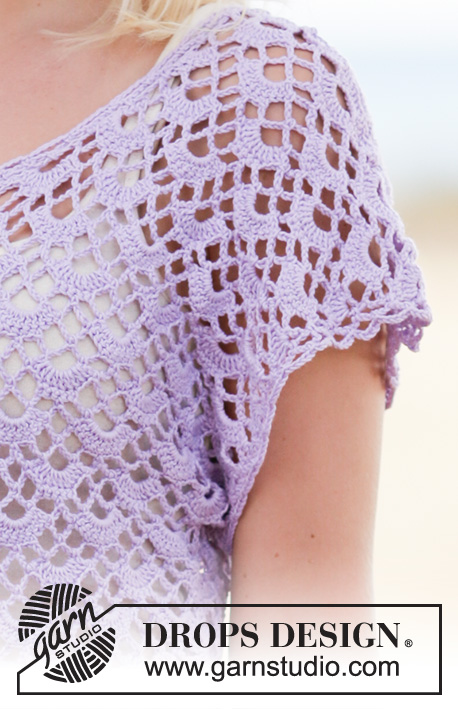

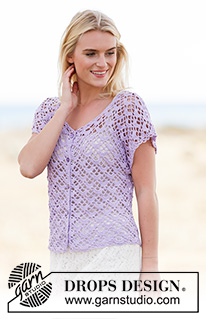
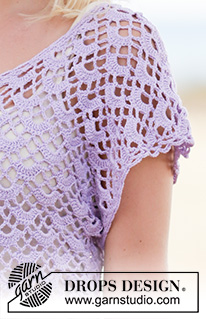



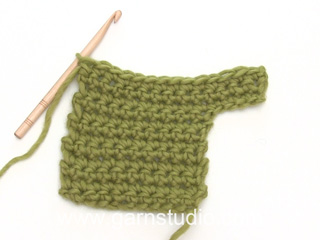














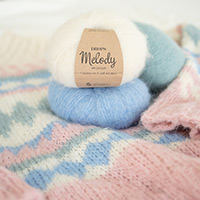


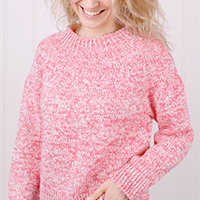


Comments / Questions (44)
Charlene Boardman wrote:
I am beginning this cardigan. Row 1: What does A.2 say to do? Ch 1 and skip st? Also why does A.4 end in 3rd chain of 5ch loop? If I move immediately to 2nd repeat beginning at A.2, what happens to the loop? I just do not understand the chart and have crocheted many things from charts. What am I doing or seeing wrong? I am so frustrated! Drops is not sold in my country, so have nobody to ask.
12.09.2016 - 15:21DROPS Design answered:
Dear Mrs Boardman, on row 1 in A.2 work 1 ch (= 1st dc (UK-English)/sc (US-English) - A.3 ends with 2 ch, A.4 beg with 3 ch (= 5-ch-space) and ends with 2 ch then A.5 beg with 3 ch (= 5-ch-space). You can get DROPS yarn and further assistance from your DROPS store all around the world, see here. Happy crocheting!
12.09.2016 - 16:18Buongiorno. Sono arrivata per entrambi i lati davanti alle 22 catenelle ma poi non riesco a capire come proseguire. Devo fare la prima riga dei diagrammi indicati (quella con la freccia tutta a sequenze di 5 catenelle) o la prima del diagramma A.x? Grazie.
21.07.2016 - 08:37DROPS Design answered:
Buongiorno Paola. Deve iniziare i diagrammi dalla riga con la freccia; è la riga tra la sequenza di cat e il diagramma A.x, quella che per i diagrammi A.3, A.4 e A.5 è formata da archi di cat e 1 m.b. Buon lavoro!
21.07.2016 - 09:06Hallo Ich habs nun mit der gleichen Anzahl Luftmaschen wie Stäbchen in der 1. Reihe versucht, ein paar Reihen gehäkelt. Und dann anschliessend am Anschlag für den Rücken angehäkelt....ich habe viel zu viele Stäbchen, es wellt und wird mit allem ziehen nicht glatt. Was mache ich falsch? Ich kanns nicht verstehen. Gibts eine Alternative? liebe Grüsse
26.06.2016 - 10:14DROPS Design answered:
Liebe Helga, wenn Sie der längere Luftmaschenanschlag stört, häkeln Sie nur so viele Lm (aber möglichst locker, damit es nicht spannt) wie nachher Stäbchen angegeben sind. Sonst passiert es, dass Sie zu viele Stb haben und es zu weit ist bzw. wellt. Aber wenn ich Sie richtig verstanden habe, haben Sie dies bereits getan. Ich kann von hier aus nicht ganz nachvollziehen, wieso Ihre Häkelarbeit dann wellig wird.
05.07.2016 - 15:53Danke für die Antwort. Wie schon erwähnt wird mein Anschlag respektive durch die 1. Reihe total wellig.....es ist nicht möglich, die Häkelarbeit nur schon gerade auszulegen. Sieht aus wie Rüschen.........so kann man doch nicht zusammensetzen oder anhäkeln.
24.06.2016 - 21:57DROPS Design answered:
Liebe Helga, siehe Antwort weiter oben.
05.07.2016 - 15:53Weil die erste Reihe dann etwas länger wird, also nicht zu stramm.
24.06.2016 - 20:17Hallo Ich verstehe den Sinn der 1. Reihe nicht. Warum kann man nicht soviele Luftmaschen anschlagen, wie man dann auch Stäbchen drauf häkelt? Ich habe mit dieser angegebenen Variante (4 Stäbchen in je 1 Luftmasche, 1 Luftmasche überspringen usw) einen völlig welligen Anfangsrand, wo ich mich jetzt schon frage, wie man das dann mit dem Rückenteil verbinden will.
24.06.2016 - 18:01DROPS Design answered:
Liebe Helga, siehe Antwort weiter oben.
05.07.2016 - 15:54Hallo allemaal, Ik begrijp de 2e helft van toer 7 niet. '...maar eindig met A8 boven A6.' Hoe moet ik dit zien? Heb je dan een losse 'driehoek' hangen of waar moet dat aan vast? De regel daarna is me ook niet duidelijk: 'Ga verder tot A8 een keer in de hoogte is gehaakt, herhaal in A2-A5 de toeren in AX.' Alvast bedankt voor de hulp!
26.08.2015 - 19:00DROPS Design answered:
Hoi Corina. Je haakt van boven naar beneden en moet nu meerderen voor de hals van het voorpand (zie ook foto). Dus je moet nu A.8 haken boven A.6 = 1 v. Dus als je begint met A.8 heb je ook een v en in de volgende toeren ga je meerderen en het voorpand wordt breder. Je haakt dus A.8 één keer in de hoogte en tegelijkertijd haak je door volgens A.X boven A.2/A.5
02.09.2015 - 16:45Noeleen wrote:
How much yarn is required for this garment? i.e how many 50g balls as i don't understand what 250-350-350-400g refers to in materials
02.08.2015 - 09:40DROPS Design answered:
Dear Noelen, yarn requirements are given for each size, ie you need 250 g DROPS Safran in 1st size / 50 g a ball DROPS Safran = 5 balls in first size (350 g/ 50 g = 7 balls in 2nd size and so on). Happy crocheting!
03.08.2015 - 09:48Salve vi ringrazio per le informazioni finora ottenute. ho realizzato il cardigan e la mia mamma ne vorrebbe uno uguale ma di una taglia inferiore. quindi le catenelle saranno 92 ..............per ottenere quanti punti alti??? aiutatemi come avete fatto nella precedente richiesta che vi ho sottoposto ......grazie attendo impaziente la risposta
29.06.2015 - 08:03DROPS Design answered:
Buongiorno Franca. Avvia 92 cat. Lavora la prima riga di m.a così: salta 3 cat (contano come 1 m.a), 1 m.a nella 4a cat, 1 m.a in ognuna delle 3 cat successive (fino a qui: 5 m.a). Poi deve: saltare 1 cat e lavorare 1 m.a in ognuna delle 4 cat successive, saltare 1 cat e lavorare 1 m.a nelle 4 cat successive e così via, in tutto 17 volte (68 m.a). Ottiene così 5 + 68 = 73 m.a. Buon lavoro!
29.06.2015 - 09:55Ho fatto i 2 davanti ora lavoro sulle cat iniziali 1 p. basso 5 cat salto 5 p.alti si formano cosi' gli archetti. quando faccio 71 cat per il dietro collo come e quando si fanno gli archetti???
16.06.2015 - 17:41DROPS Design answered:
Buonasera Franca. Dopo aver avviato le 71 cat e unito queste cat alla spalla sinistra, taglia il filo e iniziando sul diritto del lavoro, lavora la prima riga dei diagrammi A.2 – A.6 come segue: diagramma A.2, diagramma A.3, diagramma A.4 9-10-11-12 volte, diagramma A.5, e infine diagramma A.6. Prosegue poi con il diagramma A.x. Buon lavoro!
16.06.2015 - 19:57